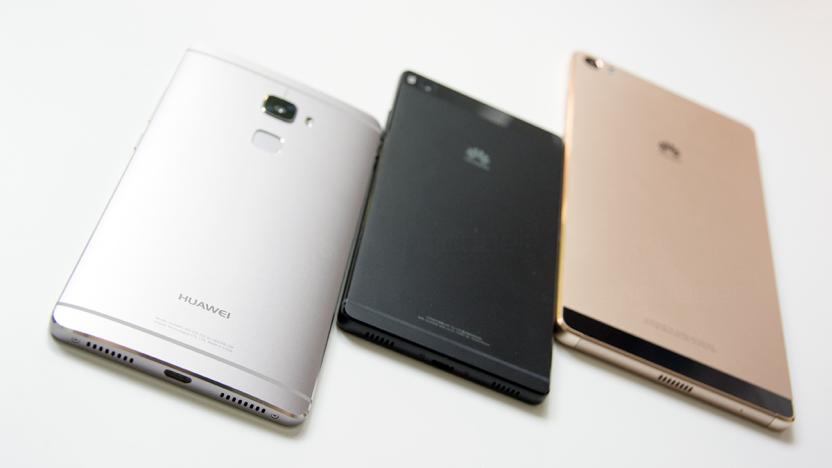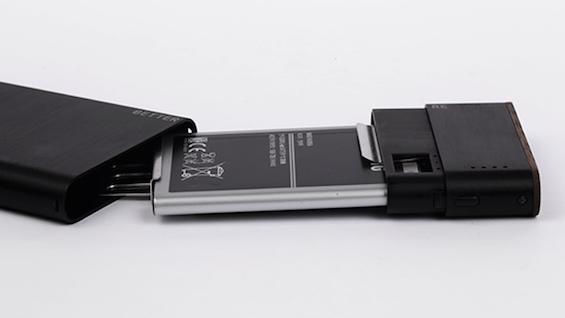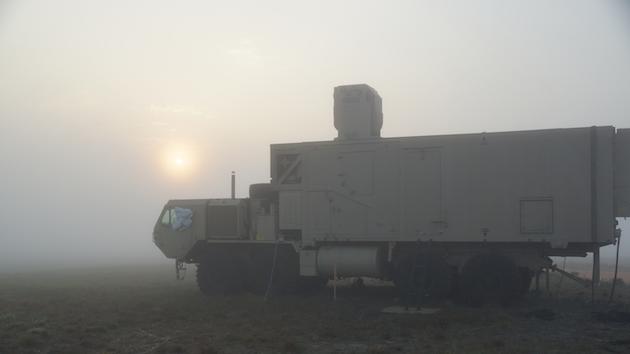LithiumIon
Latest

Lithium battery failure wipes out DARPA robot at NASA
It's not just Samsung that has problems with combusting batteries, as NASA's office of Safety and Mission Assurance has just revealed. The body has announced that NASA centers have seen at least four major explosions and a number of close calls over the last decade. The latest crisis was a fire at the Jet Propulsion Lab that wiped out one of DARPA's RoboSimian droids before a test.

Smartphone batteries with twice the life may arrive in 2017
A type of lithium battery that could make gasoline-powered cars obsolete is on track to be commercialized, according to MIT News. The "lithium metal" batteries, developed by MIT spin-off SolidEnergy, can reportedly pack the same energy as a standard lithium-ion cell in half the size. "Or, we can make a battery the same size as a lithium ion battery, but now it will last twice as long," says SolidEnergy CEO Qichao Hu.

New fuel cell tech could power phones for a week
No matter how efficient our devices get in terms of power usage, there's really only so much manufacturers can do given the limitations of the energy source: lithium-ion batteries. But researchers from Pohang University of Science and Technology in South Korea have designed what they're calling a miniaturized solid oxide fuel cell that could replace current battery tech in everything from mobile devices to drones. What's more, the tech could even be scaled up for larger applications including electric vehicles.

UN group bans lithium battery shipments from passenger planes
Lithium-ion batteries, like those commonly used in laptops and smartphones, are no longer allowed to be shipped as cargo on passenger planes, the United Nation's International Civil Aviation Organization decided this week. There's no need to worry about your carry-on gadgets here -- the ruling applies only to shipments of lithium batteries in the cargo area of a commercial airliner. The new safety measure goes into effect on April 1st, and it should hold tough until ICAO and its partners can implement new, fire-resistant packaging standards for lithium batteries. That's expected to roll out by 2018.

Finally, a lithium battery that doesn't explode
When lithium-ion batteries overheat they expand and on some occasions, erupt into flames. It's the reason low-quality hoverboards keep exploding and can't be taken on flights. Thankfully Stanford researchers have created a Li Ion battery that shuts itself down when it overheats and turns itself back on when heat levels are at a safe level.

Huawei can quick-charge your phone without hurting its battery
That fast-charging smartphone you just bought has a dirty secret: more likely than not, it's reducing the lifespan or capacity of the battery to get that breakneck speed. Huawei doesn't think you should have to compromise, though. It just showed off a lithium-ion battery whose graphite-coated anode (where current flows) allows for very quick charging without hurting either capacity or long-term longevity. How quick? With a 3,000mAh of the sort you'd find in a larger phone, Huawei can give you a 48 percent charge in just 5 minutes. Yes, you could have enough power for an evening out in the time it takes to change out of your work clothes. There's an even faster prototype that reaches 68 percent in 2 minutes, although its 600mAh capacity isn't practical at its size.

FAA: Don't pack lithium batteries in your checked bag
If you've been packing extra lithium batteries in your checked bag before a flight, you might want to avoid doing so in the future. The FAA warns that storing those batteries in luggage that'll travel in the cargo hold can "present a risk of both igniting and fueling fires." The agency wants airlines to prohibit the practice and to remind travelers at check-in not to stow extras in a checked suitcase. Worried about running out of juice for that toothbrush or point-and-shoot camera? You might want to wait until you land to pick up more batteries. [Image credit: Scott Olson/Getty Images]

Nano-sized 'yolks' should lead to longer-lasting batteries
Those eggs you might have had for breakfast? They're not just food -- they may be the key to longer-running batteries in your devices. Scientists at MIT and Tsinghua University have developed a nanoparticle battery electrode whose egg-like design is built to last. Their invention, which houses a shape-changing aluminum "yolk" in a titanium dioxide cell, can go through charging cycles without degrading like the graphite electrodes in conventional power packs. That could improve not only the overall longevity of the battery, but also its capacity and maximum power. You'd have gadgets that not only hold out for longer between charges, but don't need to be replaced quite so often under heavy use.

'Better Re' Kickstarter finds a use for old cellphone batteries
Better Re hasn't exactly smashed through the boundaries and who even knows if designer Enlighten is here to stay, but it did exceed its $50,000 Kickstarter goal for a project that's on the greener side of things. The idea is that the Better Re will repurpose the battery from your old smartphone (so long as it's of the removeable sort) into an external power source for your phone, tablet and from the looks of it, even your laptop. The pitch video claims that at the average rate we typically replace our smartphones -- every two years -- their batteries still are about 80 percent efficient. That's quite a bit of wasted and unharnessed power that could serve a purpose instead of us mining for more lithium as demand increases. So, for $39 you can tap into that energy and use it to get extra time out of your gadgets.

Here's what happens when a lithium-ion battery overheats
Lithium ion batteries are practically ubiquitous; they power everything from laptops and cell phones to cameras and tablets. But before they can start providing the juice for bigger and more demanding applications, research about their failure needs to happen. That's where the fine folks at University College London come in -- they've used 3D-and-thermal imaging to track exactly what happens when the power cells overheat, inside and out. As you can see in the GIF above, the results aren't pretty. After cranking the heat on a pair of the batteries to 250+ degrees Celsius (482 degrees Fahrenheit) and keeping an eye on them with the aforementioned techniques, researchers witnessed one of the batteries blow its top. Prior to that happening, during what's known as "thermal runaway," the core collapsed.

Packing peanuts are the key to fast-charging batteries
Hate buying some new gadget, only to wind up with a sea of packing peanuts that do little more than spill on to the floor? Don't be too quick to toss them out -- they may be the key to a new generation of lithium-ion batteries. Purdue University researchers have developed a heating process that converts these shipping leftovers into anodes (where lithium ions are stored during charging) made from carbon. On top of eliminating waste, this technique should lead to batteries that recharge much faster. The carbon anodes are only a tenth as thick as their commercially available counterparts, so they don't produce nearly as much electrical resistance.

Super-thin Kevlar layers promise safer, slimmer batteries
Scientists have spent a lot of time trying to lengthen battery life, but safety and thickness matter, too. Just ask Boeing about that first problem -- its 787 Dreamliner was grounded for months thanks to battery fires. However, a group of University of Michigan researchers may have found a way to make lithium-ion energy packs that are safer and slimmer at the same time. The team has developed Kevlar-based, nano-sized membranes that insulate the electrodes in a battery while still allowing lithium ions to pass through and create a proper circuit. The extra-thin layers should not only reduce the chances of short circuiting, but allow for more energy in a given space. You could get away with thinner batteries in smartwatches and other devices without giving up battery life... or worrying that your device will spontaneously combust, for that matter.

Boeing's Dreamliner batteries caught on fire for a few reasons
Curious about what the official word regarding the Boeing Dreamliner's faulty battery is? Of course you are. The National Transportation Safety Board says that the reason for the non-fatal fire was due to "deficiencies in the design and certification process," and has a few fingers to point. The board says that Boeing itself is at fault, calling its safety assessments of the lithium-ion units insufficient. Yuasa, the battery manufacturer, isn't free from blame either. As The Wall Street Journal notes, Yuasa's production process apparently allowed for defects that could cause short-circuiting in the battery's internal cells, and the final battery design was actually different than the one tested and certified. The NTSB goes on to call out the Federal Aviation Administration for its lack of oversight regarding the outsourcing of components in the Dreamliner as well.

Fast-charging batteries will power your gadgets for 20 years
Fast-charging batteries are all nice and good, but the lifespan matters, too -- why should you have to replace power packs (or entire devices) every couple of years ? You may not have to give up performance or longevity if researchers at Nanyang Technology University have their way. They've developed new lithium ion batteries that can reach a 70 percent charge in two minutes, but should also last for over 20 years -- several times longer than the cells in your current laptop or smartphone. The trick is using titanium dioxide nanotubes for the anode (the negative pole) instead of graphite; they both speed up the battery's chemical reactions while offering 10,000 charging cycles instead of the usual 500.

California's giant battery test is a step towards clean energy
One of the biggest challenges of switching to clean energy sources is finding a place to store excess power. That's relatively easy on a small scale, but it's much more daunting for your utility company. Southern California Edison is apparently ready to take on that challenge, however. It just launched the Tehachapi Energy Storage Project, a large-scale experiment in using lithium-ion batteries (608,832 of them, to be exact) to preserve unused electricity. For the next two years, the 32 megawatt-hours array will scoop up leftover energy from nearby sources, including a wind turbine area; SCE will be watching closely to see how the lithium-ion packs improve its grid's real world performance.

Boeing's drone-killing laser takes down targets with an Xbox controller
Boeing has a pretty storied history with lasers and now its testing one that can take out UAVs and rockets regardless of where it's installed. A recent trial run of the tech was conducted in Florida under some pretty grueling conditions (heavy fog, rain and wind), to prove that even a lower-powered version of High Energy Laser Mobile Demonstrator -- HEL MD for short -- is capable in a maritime environment. As Boeing tells it, the firm exceeded all of its goals and successfully engaged with some 150 different targets including drones and 60mm mortar shells with its 10 kilowatt laser. Wired says that the energy beam is powered by lithium ion batteries, and that the whole setup only requires a diesel-backed generator to keep the wheels of war defense moving. Meaning, running out of fuel, not munitions, is basically the only threat the energy weapon faces.

Engadget Daily: credit card skimming, floating 'Star Wars' holograms and more!
Today, we investigated the tech behind credit card skimming, looked at floating 3D video, learned about next gen lithium ion batteries and checked our Uber passenger ratings. Read on for Engadget's news highlights from the last 24 hours.

Next-generation lithium cells will double your phone's battery life
The lithium ion batteries in your mobile devices are inherently limited by the "ion" part of their name; they can safely use lithium only in the part of the cell that supplies ions, wasting a lot of potential energy. It's good news, then, that researchers at Stanford have developed a new lithium battery that could last for much, much longer. The technique allows for denser, more efficient lithium in the battery's anode (which discharges electrons) by using a nanoscopic carbon shield that keeps the unstable chemical in check -- uncontrolled, it can quickly shorten the device's lifespan.

Tesla Model S catches fire after battery puncture, Musk responds
A Tesla Model S caught fire on the highway recently after its bottom-mounted battery compartment was struck by a piece of metal. That piece of metal punched a three-inch hole through quarter-inch armor plating, impaling the car with a "peak force on the order of 25 tons" according to company CEO Elon Musk's post on the Tesla blog. Even after firefighters punctured the battery's protective cover to extinguish the fire, it never reached the passenger compartment. For his part, Musk was quick to note how low the fire ratio is in his EVs compared to traditional autos; one for every 100 million miles driven in a Tesla, while one gas-powered vehicle catches fire for every 20 million miles traveled. There's even an email thread between the affected owner and Tesla's VP of sales and service at the source, too. Spoiler alert: The company offered the owner a white loaner model for the interim. [Image source: AJ Gill / YouTube]

Tiny lithium-ion battery recharges 1000x faster than rival tech, could shrink mobile devices
Supercapacitors are often hailed as the holy grail of power supplies, but a group of researchers at the University of Illinois have developed a lithium-ion microbattery that leaves that prized solution in the dust, recharging 1,000 times faster than competing tech. Previous work done by Professor William P. King, who led the current effort, resulted in a fast-charging cathode with a 3D microstructure, and now the team has achieved a breakthrough by pairing it with an anode devised in a similar fashion. The resulting battery is said to be the most powerful in the world, avoiding the usual trade-off between longevity and power while having a footprint of just a few millimeters. By altering its composition, scientists can even optimize the contraption for more juice or increased life. It's expected that the technology could make devices 30 times smaller and help broadcast radio signals up to 30 times farther, but it'll still be a while before it winds up in a super-slim phone within your pocket. For now, the researchers have their sights set on integrating the tech with other electronic components and investigating low-cost manufacturing.








